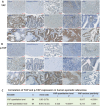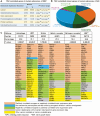Yes-associated protein plays oncogenic roles in human sporadic colorectal adenomas
- PMID: 39977302
- PMCID: PMC11923420
- DOI: 10.1093/carcin/bgaf007
Yes-associated protein plays oncogenic roles in human sporadic colorectal adenomas
Abstract
The role of Hippo-Yes-associated protein (YAP) in human colorectal cancer (CRC) presents contradictory results. We examined the function of YAP in the early stages of CRC by quantitatively measuring the expression of phospho-YAPS127 (p-YAP) and five APC-related proteins in 145 sporadic adenomas from the Tennessee Colorectal Polyp Study, conducting APC sequencing for 114 adenomas, and analyzing YAP-correlated cancer pathways using gene expression data from 326 adenomas obtained from Gene Expression Omnibus. The p-YAP expression was significantly correlated with YAP expression (r = 0.53, P < .0001) and nuclear β-catenin (r = 0.26, P = .0018) in adenoma tissues. Both p-YAP and nuclear β-catenin were associated with APC mutations (P = .05). A strong association was observed between p-YAP overexpression and advanced adenoma odds (OR = 12.62, 95% CI = 4.57-34.86, P trend < .001), which persisted after adjusting for covariates and biomarkers (OR = 12.31, 95% CI = 3.78-40.10, P trend < .0001). P-YAP exhibited a sensitivity of 77.4% and specificity of 78.2% in defining advanced versus nonadvanced adenomas. Additionally, synergistic interaction was noted between p-YAP positivity and nuclear β-catenin on advanced adenomas (OR = 16.82, 95% CI = 4.41-64.08, P < .0001). YAP-correlated genes were significantly enriched in autophagy, unfolded protein response, and sirtuin pathways showing predominantly pro-tumorigenic alterations. Collectively, YAP plays an oncogenic role in interacting with Wnt as well as other cancer pathways within human sporadic adenomas. P-YAP could be a potential biomarker for human high-risk sporadic adenomas.
Keywords: Hippo-YAP; Wnt pathway; biomarker; colorectal adenoma; oncogene.
© The Author(s) 2025. Published by Oxford University Press.
Conflict of interest statement
All the authors declare that they have no conflicts of interest with this work.
Figures






References
-
- Siegel RL, Miller KD, Jemal A.. Cancer statistics, 2020. CA A Cancer J Clinicians 2020;70:7–30. https://doi.org/10.3322/caac.21590 - DOI - PubMed
-
- Carethers JM, Jung BH.. Genetics and genetic biomarkers in sporadic colorectal cancer. Gastroenterology 2015;149:1177–90.e3. https://doi.org/10.1053/j.gastro.2015.06.047 - DOI - PMC - PubMed
-
- Vogelstein B, Papadopoulos N, Velculescu VE. et al. Cancer genome landscapes. Science 2013;339:1546–58. https://doi.org/10.1126/science.1235122 - DOI - PMC - PubMed
-
- Tomasetti C, Marchionni L, Nowak MA. et al. Only three driver gene mutations are required for the development of lung and colorectal cancers. Proc Natl Acad Sci USA 2015;112:118–23. https://doi.org/10.1073/pnas.1421839112 - DOI - PMC - PubMed
-
- Pickhardt PJ, Pooler BD, Kim DH. et al. The natural history of colorectal polyps. Gastroenterol Clin North Am 2018;47:515–36. https://doi.org/10.1016/j.gtc.2018.04.004 - DOI - PMC - PubMed
MeSH terms
Substances
Grants and funding
LinkOut - more resources
Full Text Sources
Medical
Miscellaneous

